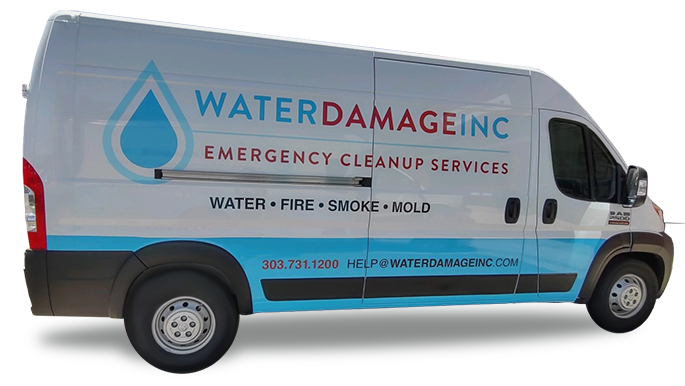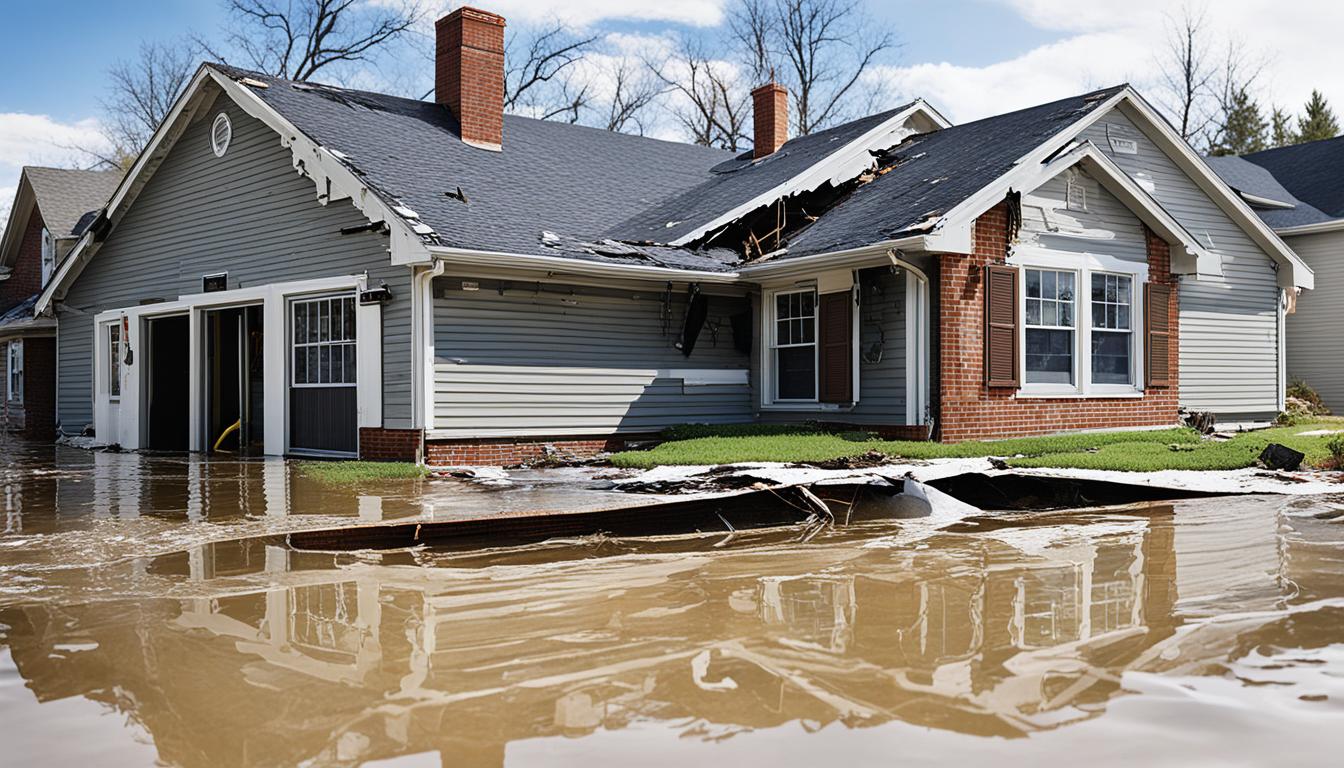Welcome to our comprehensive guide on water damage. In this article, we will explore the various types of water damage that can occur in your home. Understanding these types is crucial for identifying signs, taking necessary precautions, and protecting your property. So let’s dive in and learn more about the different types of water damage.
Key Takeaways:
- Understanding the types of water damage helps you identify signs and protect your property.
- There are common causes of water damage such as leaks, burst pipes, flooding, and roof damage.
- Signs of water damage include water stains and mold growth.
- Types of water damage include damage from clean water, gray water, and black water.
- Water damage can have detrimental effects on your home’s structure, electrical systems, and your health.
Common Causes of Water Damage
Water damage in your home can result from various sources, and understanding the common causes is crucial in preventing extensive damage. By staying vigilant and addressing these causes promptly, you can safeguard your property and ensure a safe living environment.
1. Leaks
One of the primary culprits of water damage is leaking pipes or fixtures. Over time, plumbing systems may develop cracks or loose connections, leading to water leaks. Leaks can occur in hidden areas such as behind walls or under floors, causing damage to the structure and promoting mold growth.
2. Burst Pipes
Extreme temperatures, outdated plumbing, or excessive water pressure can contribute to burst pipes. When a pipe bursts, it can release large amounts of water into your home, causing immediate and extensive damage. It is essential to address burst pipes promptly to mitigate the risk of flooding and further structural problems. We can help you with basement flooding in Denver, CO too!
3. Flooding
Natural disasters, such as hurricanes or heavy rainstorms, can result in flooding that affects your home. Excessive water entering your property can damage furniture, electrical systems, walls, and flooring. It is crucial to have proper drainage systems and protective measures in place to minimize the impact of flooding.
4. Roof Damage
A damaged roof can allow water to seep into your home, leading to significant water damage. Missing or damaged shingles, cracks, or faulty flashing can compromise the integrity of your roof and increase the risk of leaks during rainstorms. Regular roof maintenance and inspections are essential to identify and address any issues promptly.
By understanding these common causes of water damage, you can take proactive steps to prevent or mitigate the risk. Regular maintenance, prompt repairs, and proper drainage systems can go a long way in safeguarding your home from water damage.
Signs of Water Damage
When it comes to protecting your home from water damage, early detection is key. By recognizing the signs of water damage, you can take prompt action to address the issue and prevent further complications. Here are some common indicators to be aware of:
- Water Stains: Keep an eye out for discoloration or yellowing on walls, ceilings, or floors. These unsightly water stains are often a clear indication of previous or ongoing water damage.
- Musty Odor: If you notice a persistent musty smell in your home, it could be a sign of hidden water damage. Mold and mildew thrive in damp environments, so the presence of this odor suggests excess moisture.
- Puddles or Standing Water: Finding pools of water or excessive moisture in unexpected areas, such as the basement or near plumbing fixtures, is a definite red flag for water damage.
- Peeling or Bubbling Paint: Water seeping into walls can cause paint to peel, bubble, or blister. If you notice any unusual wall or paint texture changes, investigate further for potential water damage.
- Mold Growth: Mold typically thrives in damp environments, making it a common consequence of water damage. Look for visible mold growth on surfaces, as well as signs of mold, such as a fuzzy texture or black, green, or white patches.
- Sagging or Warped Walls or Ceilings: Excess moisture can weaken the structural integrity of walls and ceilings, causing them to sag or warp. If you notice any uneven surfaces, it may indicate water damage.
- Unusual Sounds: Strange noises, such as dripping or running water, within your walls or ceilings can be indicative of hidden water leaks. Pay attention to any sounds that seem out of the ordinary.
Remember, the presence of one or more of these signs does not always mean there is water damage, but they should prompt further investigation. If you notice any of these indicators, it is crucial to address the issue promptly to prevent further damage and potential health risks.
Types of Water Damage
In this section, we will explore the different types of water damage that can occur in your home. Understanding these distinctions is crucial for assessing the severity of the damage and determining the appropriate course of action.
Clean Water Damage
Clean water damage refers to water that comes from a clean source, such as a burst pipe or a leaking faucet. While this type of water may initially seem harmless, it can still cause significant damage if left untreated. Clean water damage is typically the easiest to clean up and poses the lowest risk to your health.
Gray Water Damage
Gray water damage refers to water that contains some degree of contaminants and poses a moderate risk to your health. This can include water from washing machines, showers, and sinks. Gray water damage requires prompt attention and thorough cleaning to prevent the growth of mold and bacteria.
Black Water Damage
Black water damage is the most severe and hazardous type of water damage. It contains high levels of contaminants, including sewage, chemicals, and bacteria. Black water damage can result from flooding, sewage backup, or a natural disaster. It is crucial to seek professional assistance when dealing with black water damage to ensure your safety and proper cleanup.
Now that you understand the different types of water damage, you can better assess the situation in your home and take the necessary steps to address it. Whether it’s clean water, gray water, or black water damage, timely action is vital for minimizing the impact and protecting your property.
| Type of Water Damage | Description | Risk Level |
|---|---|---|
| Clean Water Damage | Water from a clean source, such as a burst pipe or leaking faucet. | Low |
| Gray Water Damage | Water that contains some contaminants, such as from washing machines or sinks. | Moderate |
| Black Water Damage | Water that contains high levels of contaminants, including sewage and chemicals. | High |
Effects of Water Damage
Water damage can inflict severe consequences on both your home and your health. Understanding these effects is crucial for taking immediate action and minimizing further damage. In this section, we will explore the various detrimental effects of water damage, including structural damage, electrical issues, mold growth, and health risks associated with prolonged exposure.
Structural Damage
Water intrusion can weaken the structural integrity of your home. Over time, excess moisture can cause wood to rot, compromise the foundation, and damage plaster or drywall. If left unaddressed, water damage may lead to warped floors, sagging ceilings, and even structural collapse.
Electrical Issues
When water comes into contact with electrical systems, it poses a significant risk. Water damage can short-circuit wiring, trip circuit breakers, and cause power outages. Additionally, exposed electrical components combined with moisture heighten the risk of electrical shocks or fires, endangering both your safety and property.
Mold Growth
One of the most common and dangerous consequences of water damage is the growth of mold. Mold thrives in damp areas and can start to develop within 24-48 hours of a water-related incident. Exposure to mold can trigger respiratory issues, allergies, and other health problems, particularly for those with weakened immune systems.
Health Risks
Extended exposure to water damage can have serious health implications. The presence of mold, bacteria, and other contaminants in water-damaged areas can lead to respiratory problems, skin irritation, and infections. It is essential to address water damage promptly to protect the well-being of you and your loved ones.
Understanding the effects of water damage emphasizes the importance of taking immediate action and seeking professional assistance. By addressing the issue promptly, you can mitigate further damage to your property and safeguard your health.
Preventing Water Damage
Protecting your home from water damage is essential for maintaining its structural integrity and preventing costly repairs. By implementing preventive measures and taking proactive steps, you can reduce the risk of water damage in your property.
Routine Maintenance
Regular maintenance plays a crucial role in preventing water damage. Here are some key areas to focus on:
- Inspect your roof for missing or damaged shingles. Replace them promptly to prevent leaks during heavy rain.
- Clean out gutters and downspouts to ensure proper water drainage. Clogged gutters can overflow and cause water to seep into your home’s foundation.
- Check for any cracks or gaps in your home’s exterior walls or foundation. Seal them with caulk or other appropriate materials.
Proper Drainage
Effective drainage systems are essential for preventing water accumulation around your home. Consider the following:
- Ensure that the terrain around your property slopes away from the house. This will direct rainwater away from your foundation.
- Install downspout extensions to divert water at least 3-4 feet away from your home’s foundation.
- Inspect and clean your sump pump regularly to ensure it is in good working condition. This device helps prevent basement flooding.
Home Protection Devices
Investing in home protection devices adds an extra layer of defense against water damage:
- Install water leak detectors in areas prone to water damage, such as basements, utility rooms, and bathrooms. These devices will alert you to leaks or excess moisture in real-time.
- Consider installing a water flow monitoring system that can automatically shut off the main water supply if it detects abnormal flow patterns. This can help prevent major water damage in the event of a burst pipe or malfunctioning appliance.
Additional Tips
In addition to the above measures, here are some additional tips to help you prevent water damage:
- Regularly inspect and maintain your plumbing system, including pipes and fixtures, to detect any leaks or signs of deterioration.
- Keep your indoor humidity levels in check with proper ventilation and the use of dehumidifiers in damp areas.
- Know the location of your main water shut-off valve and how to quickly turn it off in case of an emergency.
By following these preventive measures, you can significantly reduce the risk of water damage in your home and safeguard your property’s value. Remember, prevention is key when it comes to protecting your home from the detrimental effects of water damage.
| Preventive Measures | Benefits |
|---|---|
| Routine Maintenance | – Identify and address potential sources of water damage – Preserve the overall condition of your home |
| Proper Drainage | – Prevent water accumulation around your home – Minimize the risk of foundation damage |
| Home Protection Devices | – Receive immediate alerts for leaks and excess moisture – Mitigate potential water damage risks |
Dealing with Water Damage
When facing water damage in your home, it is crucial to take immediate action to minimize the damage and ensure efficient restoration. By following the proper procedure and contacting professionals when necessary, you can effectively deal with water damage and protect your property.
- Assess the situation: Begin by carefully assessing the extent of the water damage. Identify the source of the water and determine whether it is clean, gray, or black water. This information will help you assess the severity of the damage and take appropriate precautions.
- Ensure safety: Prioritize your safety and the safety of others in your household. If the water damage poses any immediate risks, such as structural instability or electrical hazards, evacuate the area and secure the necessary professional assistance.
- Stop the water flow: If possible, stop the flow of water at its source. This could involve shutting off the main water supply or fixing a leaking pipe. By stopping the water flow, you can prevent further damage and limit the extent of the affected area.
- Remove excess water: Use buckets, mops, or a wet-dry vacuum cleaner to remove any standing water from the affected area. Be cautious when dealing with electrical appliances or outlets, and wear appropriate protective gear if the water is contaminated.
- Document the damage: Take photographs or videos of the water-damaged areas and any belongings that have been affected. This documentation will be crucial for insurance claims and restoration purposes.
- Contact your insurance company: Notify your insurance company of the water damage as soon as possible. Provide them with detailed information and any supporting documentation. Your insurance provider will guide you through the claims process and inform you about the coverage and benefits available to you.
- Seek professional assistance: Depending on the severity of the water damage, you may need to enlist the help of professionals. Water damage restoration companies have the expertise and equipment to effectively dry, clean, and restore your property. Contact trusted professionals in your area to assess the situation and provide a comprehensive restoration plan.
- Address mold and mildew: Water damage often leads to mold and mildew growth, which can pose serious health risks. If you notice signs of mold, such as a musty smell or visible growth, consult with professionals who specialize in mold remediation. Prompt action is crucial to prevent further damage and protect your health.
- Take preventive measures: After dealing with water damage, take proactive steps to prevent future incidents. Regularly inspect your home for leaks, maintain proper drainage systems, and address any issues promptly. By staying vigilant and implementing preventive measures, you can reduce the risk of water damage in the future.
Dealing with water damage can be stressful, but by following these steps and seeking professional assistance, you can effectively mitigate the damage and restore your home to its pre-damaged condition.
Conclusion
Being knowledgeable about the types of water damage is essential for protecting your home and property. By understanding the causes, signs, and effects of water damage, as well as implementing preventive measures and knowing how to deal with it, you can minimize the impact of water damage and maintain a safe living environment.
Water damage can occur in various ways, such as leaks, burst pipes, flooding, and roof damage. It is crucial to identify these common causes and take proactive measures to prevent water damage from happening in the first place.
Recognizing the signs of water damage is equally important. From water stains and dampness to mold growth and musty odors, knowing these indications will help you detect and address water damage early, preventing further issues and potentially costly repairs.
The effects of water damage can be severe, ranging from structural damage and electrical problems to the growth of harmful mold and health risks. By understanding these consequences, you can take immediate actions to mitigate the damage and protect your well-being.
Preventing water damage is always better than dealing with its aftermath. Regular maintenance, proper drainage systems, and installing necessary safeguards, such as sump pumps and leak detectors, can go a long way in preventing water damage and preserving the integrity of your home.
However, if you do find yourself facing water damage, it is crucial to know the correct steps to take. Acting quickly by shutting off the water source, removing standing water, and contacting professionals for restoration services can help limit the damage and ensure an efficient recovery process.
By staying informed about the different types of water damage, you can be proactive in protecting your home and property. With the right knowledge and preventive measures, you can minimize the risks and maintain a safe and secure living environment for you and your family.
FAQ
What are the different types of water damage?
The different types of water damage include damage from clean water, gray water, and black water. Clean water damage is caused by sources such as broken water supply lines or overflowing sinks. Gray water damage refers to water that may contain contaminants and can come from sources like washing machines or showers. Black water damage is the most severe type and contains unsanitary agents, typically from sewage backup or flooding.
What are the common causes of water damage?
Common causes of water damage include leaks, burst pipes, flooding, and roof damage. Leaks can occur due to faulty plumbing or appliances, while burst pipes can result from freezing temperatures or corrosion. Flooding can be caused by natural disasters or plumbing issues, and roof damage can allow water to seep into your home during heavy rainfall or storms.
What are the signs of water damage?
Signs of water damage can include water stains on walls or ceilings, damp or musty odors, peeling paint or wallpaper, warped or swollen materials, mold or mildew growth, and increased humidity levels. It’s important to promptly address these signs to prevent further damage and potential health risks.
What are the effects of water damage?
Water damage can have detrimental effects on your home and health. It can cause structural damage, weakening the foundation, walls, and floors. Electrical issues can also arise from water exposure, posing risks of fires or electrical shocks. Furthermore, water damage can lead to mold growth, which can contribute to respiratory problems and allergies.
How can I prevent water damage?
To prevent water damage, you should regularly inspect and maintain your plumbing system, including pipes, faucets, and appliances. Ensure proper drainage by cleaning gutters and downspouts, and redirecting water away from your foundation. Install a sump pump, use leak detection devices, and consider waterproofing vulnerable areas of your home, such as basements. Additionally, it’s essential to monitor your water bill for any unexpected increases, indicating a potential leak.
What should I do if I experience water damage in my home?
If you experience water damage, it’s crucial to take immediate action. Start by addressing the source of the water and stopping the flow if possible. Document the damage by taking photos or videos for insurance purposes. Remove any standing water and begin drying out the affected areas using fans, dehumidifiers, and open windows. Contact a professional restoration company to assess the extent of the damage and perform necessary repairs.
How can I deal with water damage in a safe and efficient manner?
When facing water damage, prioritize health and safety. Ensure you are wearing protective gear such as gloves and masks to avoid exposure to potentially harmful substances. Begin by extracting the water and removing damaged materials. Thoroughly dry the area to prevent mold growth. Depending on the severity of the damage, you may need to hire professionals to handle the restoration process, including repairs, mold remediation, and sanitization.
Why is understanding types of water damage important?
Understanding the types of water damage is important because it helps you assess the severity of the damage and determine the appropriate actions for mitigation and restoration. By knowing the causes, signs, and effects of water damage, as well as implementing preventive measures, you can protect your home, minimize the impact of water damage, and maintain a safe living environment.







